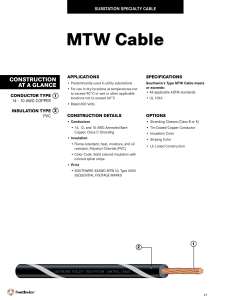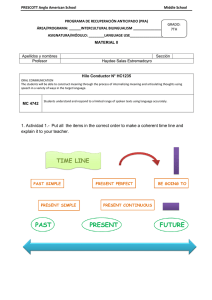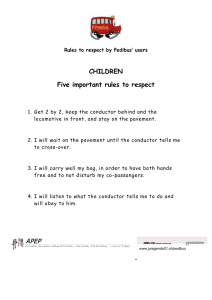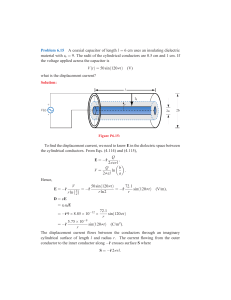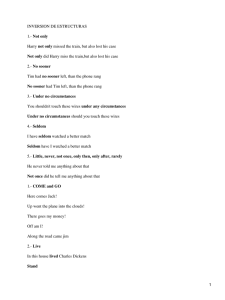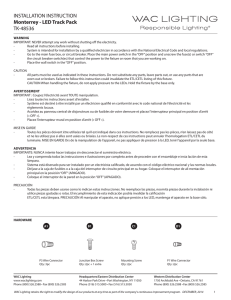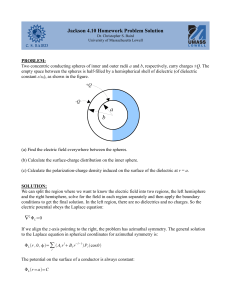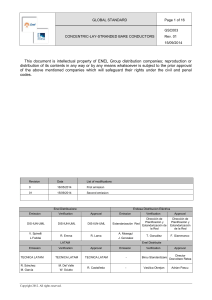Copper Conductors: Rope-Lay-Stranded Specification B 172
Anuncio
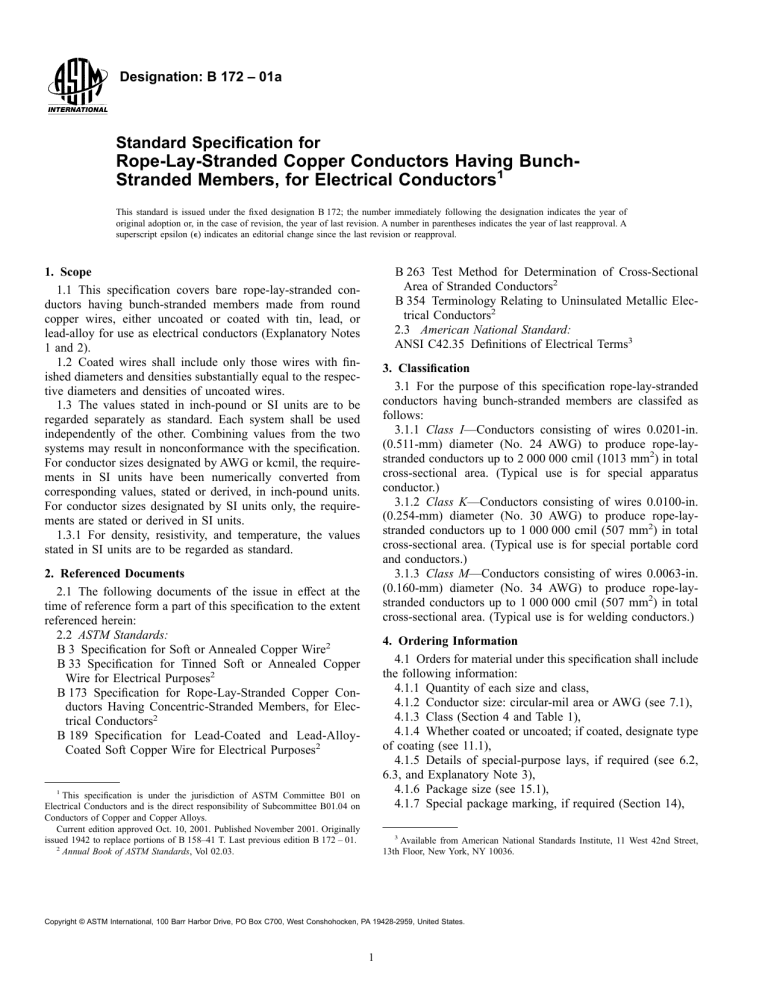
Designation: B 172 – 01a Standard Specification for Rope-Lay-Stranded Copper Conductors Having BunchStranded Members, for Electrical Conductors1 This standard is issued under the fixed designation B 172; the number immediately following the designation indicates the year of original adoption or, in the case of revision, the year of last revision. A number in parentheses indicates the year of last reapproval. A superscript epsilon (e) indicates an editorial change since the last revision or reapproval. 1. Scope 1.1 This specification covers bare rope-lay-stranded conductors having bunch-stranded members made from round copper wires, either uncoated or coated with tin, lead, or lead-alloy for use as electrical conductors (Explanatory Notes 1 and 2). 1.2 Coated wires shall include only those wires with finished diameters and densities substantially equal to the respective diameters and densities of uncoated wires. 1.3 The values stated in inch-pound or SI units are to be regarded separately as standard. Each system shall be used independently of the other. Combining values from the two systems may result in nonconformance with the specification. For conductor sizes designated by AWG or kcmil, the requirements in SI units have been numerically converted from corresponding values, stated or derived, in inch-pound units. For conductor sizes designated by SI units only, the requirements are stated or derived in SI units. 1.3.1 For density, resistivity, and temperature, the values stated in SI units are to be regarded as standard. B 263 Test Method for Determination of Cross-Sectional Area of Stranded Conductors2 B 354 Terminology Relating to Uninsulated Metallic Electrical Conductors2 2.3 American National Standard: ANSI C42.35 Definitions of Electrical Terms3 3. Classification 3.1 For the purpose of this specification rope-lay-stranded conductors having bunch-stranded members are classifed as follows: 3.1.1 Class I—Conductors consisting of wires 0.0201-in. (0.511-mm) diameter (No. 24 AWG) to produce rope-laystranded conductors up to 2 000 000 cmil (1013 mm2) in total cross-sectional area. (Typical use is for special apparatus conductor.) 3.1.2 Class K—Conductors consisting of wires 0.0100-in. (0.254-mm) diameter (No. 30 AWG) to produce rope-laystranded conductors up to 1 000 000 cmil (507 mm2) in total cross-sectional area. (Typical use is for special portable cord and conductors.) 3.1.3 Class M—Conductors consisting of wires 0.0063-in. (0.160-mm) diameter (No. 34 AWG) to produce rope-laystranded conductors up to 1 000 000 cmil (507 mm2) in total cross-sectional area. (Typical use is for welding conductors.) 2. Referenced Documents 2.1 The following documents of the issue in effect at the time of reference form a part of this specification to the extent referenced herein: 2.2 ASTM Standards: B 3 Specification for Soft or Annealed Copper Wire2 B 33 Specification for Tinned Soft or Annealed Copper Wire for Electrical Purposes2 B 173 Specification for Rope-Lay-Stranded Copper Conductors Having Concentric-Stranded Members, for Electrical Conductors2 B 189 Specification for Lead-Coated and Lead-AlloyCoated Soft Copper Wire for Electrical Purposes2 4. Ordering Information 4.1 Orders for material under this specification shall include the following information: 4.1.1 Quantity of each size and class, 4.1.2 Conductor size: circular-mil area or AWG (see 7.1), 4.1.3 Class (Section 4 and Table 1), 4.1.4 Whether coated or uncoated; if coated, designate type of coating (see 11.1), 4.1.5 Details of special-purpose lays, if required (see 6.2, 6.3, and Explanatory Note 3), 4.1.6 Package size (see 15.1), 4.1.7 Special package marking, if required (Section 14), 1 This specification is under the jurisdiction of ASTM Committee B01 on Electrical Conductors and is the direct responsibility of Subcommittee B01.04 on Conductors of Copper and Copper Alloys. Current edition approved Oct. 10, 2001. Published November 2001. Originally issued 1942 to replace portions of B 158–41 T. Last previous edition B 172 – 01. 2 Annual Book of ASTM Standards, Vol 02.03. 3 Available from American National Standards Institute, 11 West 42nd Street, 13th Floor, New York, NY 10036. Copyright © ASTM International, 100 Barr Harbor Drive, PO Box C700, West Conshohocken, PA 19428-2959, United States. 1 B 172 TABLE 1 Construction Requirements of Rope-Lay Stranded Copper Conductors Having Bunch-Stranded MembersA Class I Wire Diameter 0.0201 Size in. AWG (0.511 mm) Area of Cross Section cmil mm 2 000 000 1 900 000 1 800 000 1 750 000 1 700 000 1 600 000 1 500 000 1 400 000 1 300 000 1 250 000 1 200 000 1 100 000 1 000 000 900 000 800 000 3750 000 700 000 650 000 600 000 550 000 500 000 450 000 400 000 350 000 300 000 250 000 211 600 167 800 133 100 105 600 83 690 66 360 52 620 41 740 33 090 26 240 20 820 16 510 13 090 10 380 6530 1013 963 912 887 861 811 760 709 659 633 608 557 507 456 405 380 355 329 304 279 253 228 203 177 152 127 107 85.0 67.4 53.5 42.4 33.6 26.7 21.1 16.8 13.3 10.5 8.37 6.63 5.26 3.31 Class K Approximate MassB Nominal Strand lb/ Number ConstructionC 1000 ft. of Wires ... ... ... ... ... ... ... ... ... ... ... ... ... ... ... ... ... ... ... ... ... ... ... ... ... ... 0000 000 00 0 1 2 3 4 5 6 7 8 9 10 12 4921 4788 4522 4389 4256 3990 3724 3458 3192 3059 2926 2793 2527 2261 1995 1862 1729 1596 1470 1372 1225 1127 980 882 735 637 532 418 342 266 210 161 133 105 84 63 ... ... ... ... ... 19 by 7 by 37 19 by 7 by 36 19 by 7 by 34 19 by 7 by 33 19 by 7 by 32 19 by 7 by 30 19 by 7 by 28 19 by 7 by 26 19 by 7 by 24 19 by 7 by 23 19 by 7 by 22 19 by 7 by 21 19 by 7 by 19 19 by 7 by 17 19 by 7 by 15 19 by 7 by 14 19 by 7 by 13 19 by 7 by 12 7 by 7 by 30 7 by 7 by 28 7 by 7 by 25 7 by 7 by 23 7 by 7 by 20 7 by 7 by 18 7 by 7 by 15 7 by 7 by 13 19 by 28 19 by 22 19 by 18 19 by 14 7 by 30 7 by 23 7 by 19 7 by 15 7 by 12 7 by 9 ... ... ... ... ... 6439 6265 5917 5743 5569 5221 4873 4525 4177 4003 3829 3655 3307 2959 2611 2436 2262 2088 1906 1779 1588 1461 1270 1143 953 826 683 537 439 342 267 205 169 134 107 80 ... ... ... ... ... kg/ km 9583 9324 8806 8547 8288 7770 7252 6734 6216 5957 5698 5439 4921 4403 3885 3626 3367 3108 2836 2647 2363 2174 1891 1701 1418 1229 1017 799 654 508 397 305 252 199 159 119 ... ... ... ... ... Wire Diameter 0.0100 in. (0.254 mm) Class M Approximate MassB Nominal Strand lb/ Number ConstructionC 1000 ft. of Wires ... ... ... ... ... ... ... ... ... ... ... ... 10 101 9065 7980 7581 6916 6517 5985 5453 5054 4522 3990 3458 2989 2499 2107 1666 1323 1064 836 665 532 420 336 266 210 168 133 ... ... ... ... ... ... ... ... ... ... ... ... ... ... 37 by 7 by 39 37 by 7 by 35 19 by 7 by 60 19 by 7 by 57 19 by 7 by 52 19 by 7 by 49 19 by 7 by 45 19 by 7 by 41 19 by 7 by 38 19 by 7 by 34 19 by 7 by 30 19 by 7 by 26 7 by 7 by 61 7 by 7 by 51 7 by 7 by 43 7 by 7 by 34 7 by 7 by 27 19 by 56 19 by 44 19 by 35 19 by 28 7 by 60 7 by 48 7 by 38 7 by 30 7 by 24 7 by 19 ... ... ... ... ... ... ... ... ... ... ... ... ... ... 3272 2936 2585 2455 2240 2111 1938 1766 1637 1465 1292 1120 959 802 676 535 424 338 266 211 169 132 106 84 66 53 42 ... ... kg/ km ... ... ... ... ... ... ... ... ... ... ... ... 4869 4369 3846 3654 3333 3141 2885 2628 2436 2180 1923 1667 1427 1193 1006 795 632 503 395 315 252 197 157 125 98 79 62 ... ... Wire Diameter 0.0063 in. (0.160 mm) Approximate MassB Nominal Strand lb/ Number ConstructionC 1000 ft. of Wires ... ... ... ... ... ... ... ... ... ... ... ... 25 193 22 631 20 069 18 788 17 507 16 226 14 945 13 664 12 691 11 396 10 101 8806 7581 6384 5320 4256 3325 2646 2107 1666 1323 1064 836 665 532 420 336 259 168 ... ... ... ... ... ... ... ... ... ... ... ... 61 by 7 by 59 61 by 7 by 53 61 by 7 by 47 61 by 7 by 44 61 by 7 by 41 61 by 7 by 38 61 by 7 by 35 61 by 7 by 32 37 by 7 by 49 37 by 7 by 44 37 by 7 by 39 37 by 7 by 34 19 by 7 by 57 19 by 7 by 48 19 by 7 by 40 19 by 7 by 32 19 by 7 by 25 7 by 7 by 54 7 by 7 by 43 7 by 7 by 34 7 by 7 by 27 19 by 56 19 by 44 19 by 35 19 by 28 7 by 60 7 by 48 7 by 37 7 by 24 ... ... ... ... ... ... ... ... ... ... ... ... 3239 2909 2580 2415 2251 2086 1921 1757 1631 1465 1298 1132 975 821 684 547 427 337 268 212 168 134 105 84 67 52 42 32 21 kg/ km ... ... ... ... ... ... ... ... ... ... ... ... 4819 4329 3839 3594 3349 3104 2859 2614 2428 2180 1932 1685 1450 1221 1018 814 636 501 399 316 251 200 157 125 100 78 62 48 31 A The constructions shown in this table are typical of those used in the industry. It is not intended that this table preclude other constructions which may be desireable for specific applications. The constructions shown provide for a finished, non-covered, stranded conductor approximately of the area indicated. When specified by the purchaser, the number or size of wires may be increased to provide additional area to compensate for draw-down during subsequent processing. B Values for the mass of the completed conductor are approximate. The mass values are based upon the standard stranding increments listed in Explanatory Note 6. C Strand Construction—#A by #B by #C: where #C is the number of wires in each bunch-stranded member; #B is the number of bunch stranded members which make-up each rope-stranded member; and #A (where used) is the number of rope-stranded members in the conductor. Where #A is not given, the conductor consists of one rope-stranded member. For example, 19 by 7 by 32 indicates a construction consisting of 19 rope-stranded members, each of which consists of 7 bunch-stranded members with 32 wires each. 4.1.8 Lagging, if required (see 15.2), and 4.1.9 Place of inspection (Section 13). 5.3 Joints shall be so constructed and so disposed throughout the conductor that the diameter or configuration of the completed conductor is not substantially affected, and so that the flexibility of the completed conductor is not adversely affected. 5. Joints 5.1 Necessary joints in wires or in groups of wires shall be made in accordance with accepted commercial practice, taking into account the size of the wire or group of wires as related to the size of the entire conductor. 5.2 Bunch-stranded members or rope-stranded members forming the completed conductor may be joined as a unit by soldering, brazing, or welding. 6. Lay (Explanatory Note 3) 6.1 Conductors of the same size and description furnished on one order shall have the same lay. 6.2 The length of lay of the outer layer of the rope-laystranded conductor shall not be less than 8 nor more than 16 2 B 172 met, but those prescribed in 8.4.1 are not met, a retest shall be permitted wherein all wires of a conductor of 100 wires or less, or 100 wires selected at random throughout a conductor of more than 100 wires, shall be tested for the purpose of final determination of conformance to 8.4. 8.6 Elongation tests to determine compliance shall not be made on the conductor as a unit. 8.7 If a tinning, lead-coating, or lead alloy-coating test is required, it shall be made on the wires prior to stranding. times the outside diameter of the completed conductor. The length of lay of the other layers shall be at the option of the manufacturer unless specifically agreed upon. The direction of lay of the outer layer shall be left-hand, unless the direction of lay is specified otherwise by the purchaser. The direction of lay of the other layers shall be reversed in successive layers, unless otherwise agreed upon by the manufacturer and the purchaser. 6.3 The length of lay of the bunch-stranded and ropestranded members shall be not more than 30 times the outside diameter of the member. The direction of lay shall be at the option of the manufacturer unless specifically agreed upon. 6.4 In very flexible conductors, such as welding conductor, the direction of lay of the stranded members forming rope-laystranded conductor may be in the same, rather than in reversed, directions as prescribed above. 9. Density 9.1 For the purpose of calculating mass, cross sections, etc., the density of copper shall be taken as 8.89 g/cm 3(0.32117 lb/in.3) at 20°C (Explanatory Note 5). 10. Mass and Resistance 10.1 The mass and electrical resistance of a unit length of stranded conductor are a function of the length of lay (Explanatory Note 6). 7. Construction 7.1 The area of cross section, and the number and diameter of wires for a variety of strand constructions in general use are shown in Table 1. 7.2 The number of individual wires may vary slightly from those shown in Table 1, provided the nominal cross-sectional area of the conductor at any point be not less than that specified. 11. Requirements for Wires 11.1 The purchaser shall designate the type of wire and type of coating, if any, to be used in the conductor. 11.1.1 Before stranding, uncoated wire shall meet the requirements of Specification B 3. 11.1.2 Before stranding, tinned wire shall meet the requirements of Specification B 33. 11.1.3 Before stranding, lead coated and lead-alloy coated wire shall meet the requirements of Specification B 189. 11.2 These requirements shall not prohibit the manufacture of conductors from uncoated hard-drawn wires that are annealed after stranding. 8. Physical and Electrical Tests 8.1 Tests for the electrical properties of wires composing conductors made from soft or annealed copper wire, bare or coated, shall be made before stranding. 8.2 Tests for the physical properties of soft or annealed copper wire, bare or coated, may be made upon the wires before stranding or upon wires removed from the completed stranded conductors, but need not be made upon both. Care shall be taken to avoid mechanical injury and stretching when removing wires from the conductor for the purpose of testing. 8.3 The physical properties of wire when tested before stranding shall conform to the applicable requirements of 11.1. 8.4 The physical properties of wires removed from the completed stranded conductor shall be permitted to vary from the applicable requirements of 11.1 by the following amounts (Explanatory Note 4): 8.4.1 Average of Results Obtained on All Wires Tested—The percent minimum elongation may be reduced by the value of 5 % from the values required for unstranded wires as specified by Specifications B 3, B 33, or B 189, as applicable. For example, where the unstranded wire specification requires minimum elongation of 30 %, wire of that material removed from Specification B 172 stranded conductor shall meet a minimum elongation value of 25 %. 8.4.2 Results Obtained on Individual Wires—The percent minimum elongation may be reduced by the value of 15 % from the values required for unstranded wires as specified by Specifications B 3, B 33, or B 189, as applicable. For example, where the unstranded wire specification requires minimum elongation of 30 %, wire of that material removed from Specification B 172 stranded conductor shall meet a minimum elongation value of 15 %. If the reduction results in minimum elongation of less than 5 %, a minimum of 5 % shall apply. 8.5 In the event that the requirements prescribed in 8.4.2 are 12. Variation in Area 12.1 The calculated area of cross section of a stranded conductor expressed in circular mils shall be the product of the square of the specified diameter in mils of the individual wires times the number of wires prescribed (see Note 1). NOTE 1—The calculated area of such cables as may incorporate more than one size of component wires should be the sum of the areas of the different sizes of wires. 12.2 The area of cross section of a completed stranded conductor designated as an AWG size shall be not less than 98 % of the area indicated in Column 1 of Table 1 for sizes 211 600 cmil (107 mm2) and smaller. The area of cross section of a completed stranded conductor not designated as an AWG size shall be not less than 98 % of a calculated value obtained as prescribed in 12.1. 12.3 The area of cross section of a conductor shall be determined by Test Method B 263. In applying this method, the increment of linear density resulting from stranding may be the applicable value listed in Explanatory Note 6, or may be calculated from the measured component dimensions of the sample under test. In case of question regarding area compliance, the actual linear density increment due to stranding shall be calculated. 13. Inspection 13.1 All tests and inspection shall be made at the place of 3 B 172 manufacture unless otherwise especially agreed upon between the manufacturer and the purchaser at the time of purchase. The manufacturer shall afford the inspector representing the purchaser all reasonable facilities, without charge, to satisfy him that the material is being furnished in accordance with this specification. 15. Packaging and Package Marking 15.1 Package sizes for conductors shall be agreed upon between the manufacturer and the purchaser in the placing of individual orders. 15.2 The conductors shall be protected against damage in ordinary handling and shipping. If heavy wood lagging is required, it shall be specified by the purchaser at the time of purchase. 14. Product Marking 14.1 The net mass, length (or lengths, if more than one length is included in the package), size, kind of conductor, purchase order number, and any other marks required by the purchase order shall be marked on a tag attached to the end of the conductor inside of the package. The same information, together with the manufacturer’s serial number (if any) and all shipping marks required by the purchaser, shall appear on the outside of each package. 16. Keywords 16.1 copper electrical conductor; electrical conductor; electrical conductor—copper; rope-lay-stranded copper conductors; stranded copper conductor EXPLANATORY NOTES NOTE 1—In this specification only rope-lay-stranded conductors constructed with bunch-stranded members are designated. Requirements for rope-lay-stranded conductors constructed with concentric-lay-stranded members will be found in Specification B 173. NOTE 2—For definitions of terms relating to conductors, reference should be made to ANSI C42.35 and Terminology B 354. NOTE 3—Certain types of insulated conductors may require a shorter lay than other conductors. It is expected that departures from the provision of this specification because of special requirements relative to length of lay, direction of lay, and direction of lay of successive layers will be agreed upon between the manufacturer and the purchaser. NOTE 4—Wires removed from stranded conductors and straightened for tests will have altered physical properties due to cold working of the material. The reduced elongation requirement for wires removed from stranded conductors reflects this condition. NOTE 5—The value of density of copper is in accordance with the International Annealed Copper Standard. The corresponding value at 0°C is 8.90 g/cm 3(0.32150 lb/in.3). Density calculations involving coated wire should consider the variation of coated wire density from the density of uncoated copper wire. The relative affect of the coating density on the overall wire density becomes greater as wire diameters decrease. NOTE 6—The following values approximate the incremental increase in mass and the incremental decrease in resistance of rope-lay stranded conductor as a result of stranding. The values are sufficiently accurate for most purposes and may be used when more precise values are not available. They are as follows: Construction Increment of Linear Density and Resistance, % Rope-lay-stranded conductors (Classes I, K, and M): 7 by bunch-stranded members 19 by bunch-stranded members 7 by 7 by bunch-stranded members 19 by 7 by bunch-stranded members 37 by 7 by bunch-stranded members 61 by 7 by bunch-stranded members ASTM International takes no position respecting the validity of any patent rights asserted in connection with any item mentioned in this standard. Users of this standard are expressly advised that determination of the validity of any such patent rights, and the risk of infringement of such rights, are entirely their own responsibility. This standard is subject to revision at any time by the responsible technical committee and must be reviewed every five years and if not revised, either reapproved or withdrawn. Your comments are invited either for revision of this standard or for additional standards and should be addressed to ASTM International Headquarters. Your comments will receive careful consideration at a meeting of the responsible technical committee, which you may attend. If you feel that your comments have not received a fair hearing you should make your views known to the ASTM Committee on Standards, at the address shown below. This standard is copyrighted by ASTM International, 100 Barr Harbor Drive, PO Box C700, West Conshohocken, PA 19428-2959, United States. Individual reprints (single or multiple copies) of this standard may be obtained by contacting ASTM at the above address or at 610-832-9585 (phone), 610-832-9555 (fax), or [email protected] (e-mail); or through the ASTM website (www.astm.org). 4 4 5 6 7 7 7
